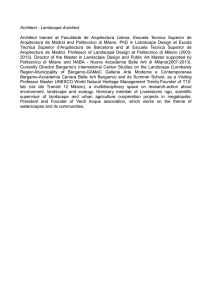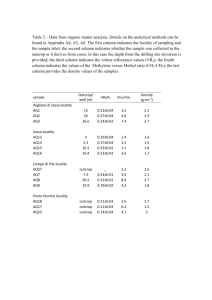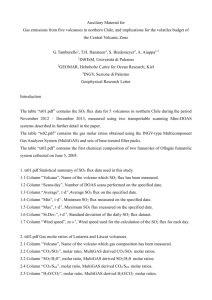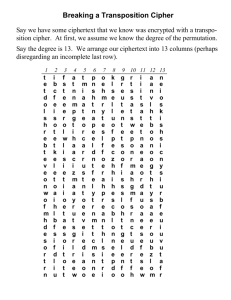README.
advertisement
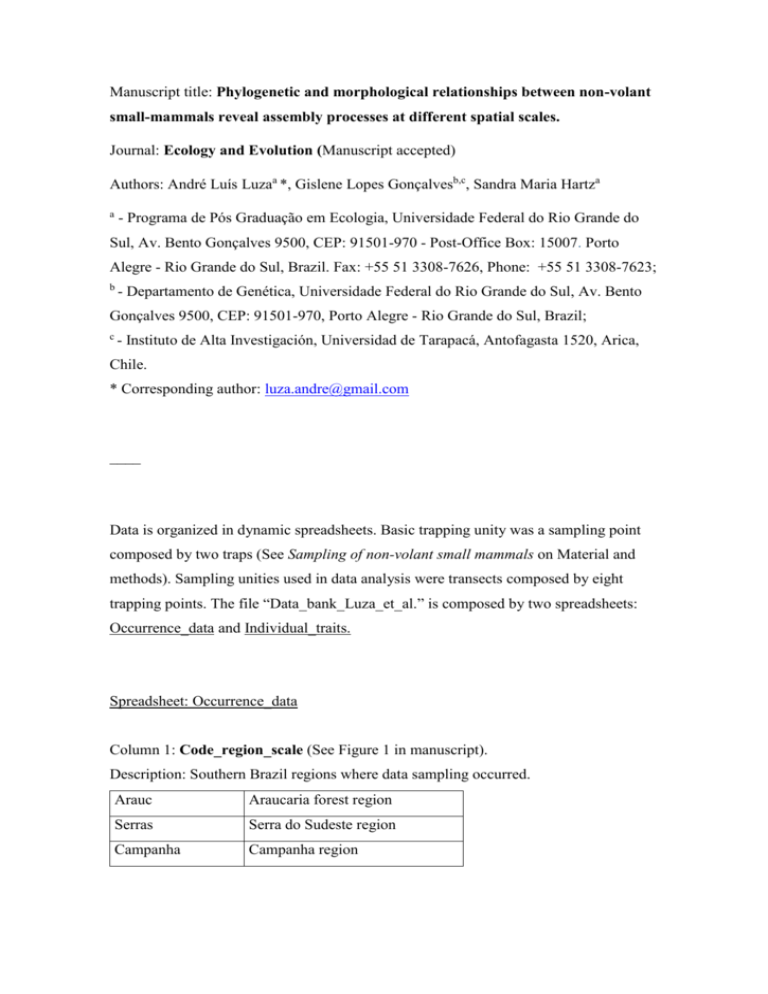
Manuscript title: Phylogenetic and morphological relationships between non-volant small-mammals reveal assembly processes at different spatial scales. Journal: Ecology and Evolution (Manuscript accepted) Authors: André Luís Luzaa *, Gislene Lopes Gonçalvesb,c, Sandra Maria Hartza a - Programa de Pós Graduação em Ecologia, Universidade Federal do Rio Grande do Sul, Av. Bento Gonçalves 9500, CEP: 91501-970 - Post-Office Box: 15007. Porto Alegre - Rio Grande do Sul, Brazil. Fax: +55 51 3308-7626, Phone: +55 51 3308-7623; b - Departamento de Genética, Universidade Federal do Rio Grande do Sul, Av. Bento Gonçalves 9500, CEP: 91501-970, Porto Alegre - Rio Grande do Sul, Brazil; c - Instituto de Alta Investigación, Universidad de Tarapacá, Antofagasta 1520, Arica, Chile. * Corresponding author: luza.andre@gmail.com ____ Data is organized in dynamic spreadsheets. Basic trapping unity was a sampling point composed by two traps (See Sampling of non-volant small mammals on Material and methods). Sampling unities used in data analysis were transects composed by eight trapping points. The file “Data_bank_Luza_et_al.” is composed by two spreadsheets: Occurrence_data and Individual_traits. Spreadsheet: Occurrence_data Column 1: Code_region_scale (See Figure 1 in manuscript). Description: Southern Brazil regions where data sampling occurred. Arauc Araucaria forest region Serras Serra do Sudeste region Campanha Campanha region Column 2: Code_Landscape_scale (See figures 1, 3, 4 and 5 in manuscript). Description: Nomenclature following Azpiroz et al. (2012) and Overbeck et al. (2007). Ecotones Between Brazilian Upland Grasslands And Landscape D E_CAL Araucaria Forest Ecotones Between Pampa Grasslands (Northern Campos) Landscape H E_CAR1 And Seasonal Forest Ecotones Between Pampa Grasslands (Northern Campos) Landscape E E_CAR2 And Seasonal Forest Ecotones Between Pampa Grasslands (Northern Campos) Landscape B E_CAR3 And Seasonal Forest Ecotones Between Pampa Grasslands (Northern Campos) Landscape I E_CCB And Seasonal Forest Ecotones Between Pampa Grasslands (Northern Campos) Landscape F E_CSR And Seasonal Forest Ecotones Between Brazilian Upland Grasslands And Landscape A E_FAR Araucaria Forest Ecotones Between Pampa Grasslands (Northern Campos) Landscape C E_FSI And Seasonal Forest Ecotones Between Brazilian Upland Grasslands And Landscape G E_FTR_FAR Araucaria/Atlantic Forest Column 3: Code_transect_scale_sampling_unity. Description: Basic sampling unity used in data analysis. Two numbers and one letter. First number equals to transect (1 (grassland interior) to 8 (forest interior); Figure S1); second number equals to grid replica within landscape (1 and 2). Letter equal to Landscapes described in Column 2. Example: 11D - transect 1 on grid 1 from landscape D. Fig. S1: Schematic figure of the sampling grid utilized. Full circles represent the capture points. The numbers of the transects (T) and points (P) are shown on the left and at the top. The distances between transects and the length of the grid are shown on the right side. The distance between points and the width of the grid are shown below. The wavy horizontal line in the middle represents the forest edge. Column 4: Sampling_point Description: Most basic information concerning the occurrence of species and individuals. Each point was composed by Tomahawk trap and one Sherman trap. The union of eight points formed a transect (Figure S1). Legend: t = transect; p = point. Example: t1p1 = point 1 from transect 1; t1p2 = point 2 from transect 1. Column 5: Order Description: Taxonomic order following Wilson & Reeder (2005). Column 6: Family Description: Taxonomic family following Wilson & Reeder (2005). Column 7: Tribe Description: Taxonomic tribes following Wilson & Reeder (2005) and Voss & Jansa (2009). Column 8: Species_presence_code Description: Species identity. Column 9: Individual_code Description: Individual identity. Example: individual D52akpa - landscape (D), individual number (52), species abbreviation (akpa). Species abbreviation Akodon azarae akaz Akodon montensis akmo Akodon paranaesis akpa Akodon reigi akre Akodon serrensis akse Akodon sp. aksp Brucepattersonius iheringi brih Dasyprocta azarae daaz Delomys dorsalis dedo Deltamys sp. desp Didelphis albiventris dial Didelphis aurita diau Gracilinanus microtarsus grmi Monodelphis dimidiata modi Necromys lasiurus nela Nectomys squamipes nesq Oligoryzomys nigripes olni Oxymycterus nasutus oxna Oxymycterus sp. oxsp Scapteromys meridionalis scme Sooretamys angouya soan Thaptomys nigrita thni Column 10: Presence/absence Description: Presence of species and individuals in each sampling point. Observations: Other data relevant to data analysis are available at online version of manuscript. These includes Table S1 (Mean values of non-volant small-mammal functional traits from grassland-forest ecotones in southern Brazil) and Appendix S1 (List of species, genes and the correspondent GenBank acession numbers included in the sequence dataset used to perform phylogenetic reconstruction). Spreadsheet: Individual_traits Column 1: Species Description: Species which individuals belong. Column 2: Individual_code Description: Individual identity. Example: individual D52akpa - landscape (D), individual number (52), species abbreviation (akpa). Column 3: Tail length Description: Individual tail length, in millimeters. Tail length was measured from the beginning (near to anus) to the end of the tail. Column 4: Body length Description: Individual body length, in millimeters. Body length was measured from snout to the beginning of the tail. Column 5: Foot length Description: Foot length, in millimeters. Foot length was measured from heel to the point of toes. Column 6: Claw size Description: Claw size, in millimeters. Initially we measured foot length without claw (as descripted above) and total foot length (including the claw). Claw size was the subtraction of the two measurements. Column 7: Ear size Description: Ear size, in millimeters. Ear size (auricle) was measured from beginning of ear canal (in the bottom region of concha and between tragus and anti-tragus) to the top of helix. Column 8: Body mass Description: Body mass, in grams. References Azpiroz, A.B., Pablo Isacch, J., Dias, R.A., Di Giacomo, A.S., Fontana, C.S. & Morales Palarea, C. (2012) Ecology and conservation of grassland birds in southeastern South America: a review. Journal of Field Ornithology, 83, 217-246. Overbeck, G.E., Mueller, S.C., Fidelis, A., Pfadenhauer, J., Pillar, V.D., Blanco, C.C., Boldrini, I.I., Both, R. & Forneck, E.D. (2007) Brazil's neglected biome: The South Brazilian Campos. Perspectives in Plant Ecology Evolution and Systematics, 9, 101-116. Voss, R.S. & Jansa, S.A. (2009) Phylogenetic Relationships and Classification of Didelphid Marsupials, an Extant Radiation of New World Metatherian Mammals. Bulletin of the American Museum of Natural History, 322, 1-177. DOI: http://dx.doi.org/10.1206/322.1. Wilson, D.E. & Reeder, D.M. (2005) Mammal species of the world: A taxonomic and geographic reference. Johns Hopkins University Press. 2000 p.
